Sixty Students Participate in the 2010 Rochester Symposium for Undergraduate Physics Students (RSPS)
April 17, 2010 marked the day of the twenty-ninth Annual Rochester Symposium for Undergraduate Physics Students (RSPS), held this year at the University of Rochester. Thirteen University of Rochester Physics students gave formal presentations about their research while three displayed posters. Overall, sixty undergraduates participated by either attending or speaking about their research.
The northeast regional RSPS conference is typically held each year during the Spring semester. This year's participants represented the University of Rochester, Houghton College, U.S. Military Academy at West Point, SUNY Brockport, Colgate University, SUNY Binghamton, Vassar College, Grove City College, Saint Peter's College, Siena College, SUNY Oswego, and Ithaca College.
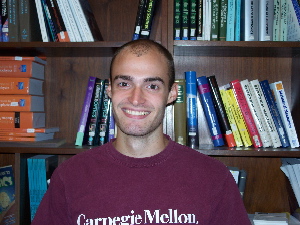
Dale McElhone, "Empirical Physical Modeling of the Saxophone."
Advisors: Mark Sterling and Professor Mark Bocko, Department of Electrical and Computer Engineering, University of Rochester
Empirical physical modeling is a method of synthesizing realistic musical sounds by employing acoustical measurements from real instruments. In this method, the acoustic waves both interior to the instrument and radiated to the environment are computed through the simulation of a physical model. The two pieces of data required by the model are the acoustic impedance function and the radiation transfer function, both of which are unique to each fingering on a given instrument. When all fingering combinations have been measured, a physical model can be established for that instrument. In addition to these acoustic measurements, the synthesis model requires a description of the physics of the reed and interaction of the player's vocal tract with the instrument. This approach has been used to synthesize saxophone tones, and the model could be capable of producing the extended range of sounds that are possible on the family of saxophones, including altissimo, quarter tones and multiphonics.
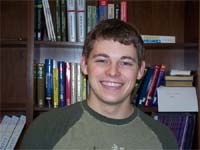
Victor Kucherov, "Polarons in DNA Oligomers."
Advisors: Colin Kinz-Thompson and Professor Esther Conwell, University of Rochester
The transport of holes on short DNA duplexes containing adenine (A) and thymine (T) pairs capped with a "hole donor" and interspersed with a "hole acceptor" molecule has been the focus of intense recent study. It has been shown in both theoretical and experimental research that a hole on an A/T duplex exists as a polaron, peaking on the A side and extending two to three As in either direction. Our project focused on the work of Zeidan et al., who utilized photoinduction of the hole donor perylenediimide chromophore (P) and the base guanine (G) as a hole acceptor in duplexes P-AnGAmG, for values of n ranging from 0 - 4, 6 and the total number of As and Gs adding to 7. Their work analyzed the percentage yield of charge separation (P--AnG+AmG) versus hole recombination (P-AnGAmG) created for each sequence with initial hole injection on the first A (P--A+An-1GAmG). It was found that when n was increased from 0 (labeled in their paper 1G) to 3 (4G), the percentage of holes making it to the first G dropped from 100% to 19% (within 5% accuracy).
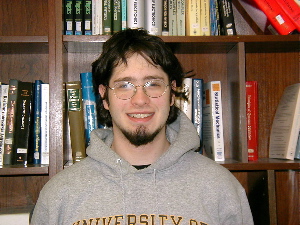
Isaac Richter, "The Image Server in Chimera."
Advisors: Antonio Kanaan, Paulo Henrique da Silva, and Shashi Kanbur, University of Rochester, Federal University of Santa Catarina, SUNY Oswego
One of the biggest obstacles in modern astronomical observation is the need to station a human operator at the telescope during observations. For observing projects requiring systematic studies of the sky over long periods, having an automated system to take the observations would allow researchers to continue to collect a month's worth of data without needing to spend 30 nights at a telescope. The Chimera Observatory Automation System is a project aimed at developing the requisite software for an intelligent autonomous robotic observatory. While such software exists, our goal is to develop a modular observatory control system that can be given additional functionality simply by writing a new Python module. End-user observatories will be able to add support for new equipment by writing a simple Python interface if one doesn't already exist. Chimera is also set up for remote operation, allowing an observatory to be controlled from anywhere in the world, and individual instruments to be connected to separate but networked computers. Many of the modules and much of the overall framework had already been written by Paulo Henrique da Silva and Antonio Kanaan before we began our summer 2008 IRES program. We will present the theory of how Chimera works, discuss the implications of a completely autonomous telescope, and demonstrate the software in action.
Vladimir LankevichVladimir Lankevich, "Investigation of de-Protonation of Proteins During Cluster Formation."
Advisor: Dr. Vassiliy Lubchenko of the University of Houston
Interactions between protein molecules govern most physiological processes and many important laboratory procedures. The formation of unwanted protein complexes may lead to serious pathological conditions such as sickle cell anemia. Mesoscopic clusters of a protein-rich solution have been recently observed in protein solutions. These clusters are likely nucleation sites for protein aggregates, such as crystals or sickle cell anemia fibers. The microscopic origin of the mesoscopic clusters is not known. Preliminary results indicate the clusters result from the formation of long-living protein complexes stabilized at high protein concentration. The mechanism of the formation of such complexes in solutions of the protein lysozyme is the subject of the present study. Because of the high net charge +7 and little dielectric screening, the lysozyme molecules are subject to strong Coulombic repulsion, which would suppress complex formation. We propose that de-protonation of surface residues occurs when the protein-protein distance is small, which leads to a decrease in the repulsion between the proteins and thus facilitates complex formation. GROMACS software package is used to test this hypothesis by means of direct molecular modeling. The objective of the molecular dynamics simulation is to establish whether the hydrogen bonds between protons and surface residues of the protein are destabilized in the presence of another protein molecule. As part of estimating the electric field stemming from this other proteinmolecule, we are also employing the GROMACS package to establish whether the dielectric constant of the several water layers confined between the two proteinmolecules significantly differs from its bulk value.
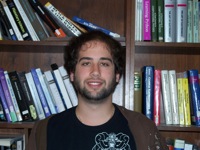
Benjamin Weinert, "Study of Muon Reconstruction in a High Energy Electron- Positron Collider."
Advisor: Professor Steven Manly, University of Rochester
With the advancements in modern technology it is possible to dig deeper and deeper into the quantum world. Currently a new particle collider design, the International Linear Collider (ILC), is in the works. The ILC is a linear collider that shoots electrons and positrons at each other at 500 GeV. The main purpose of the ILC is to research any discoveries made by the LHC, but in a lot more detail. These discoveries could range from measuring the properties of the Higgs boson, looking for light supersymmetric particles that could be candidates for dark matter, and measuring the number of, size, and shape of any extra dimensions if they exist. This project focused on the muon system of the SiD detector at the ILC. By constructing a muon reconstruction program it is possible to recreate the muon tracks of the original event. This makes it possible to differentiate muon tracks from that of minimum ionizing particles, like pions, that make it to the muon system. It will also help to eliminate background events that come from outside of the detector. This project was supported in part by NSF award PHY-0242483.
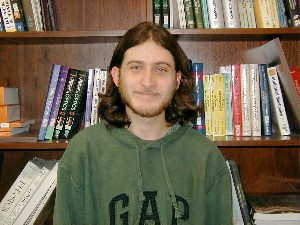
Adi Robinson, "Analyzing Ge Detector Pulses Using a Moving Window Deconvolution Algorithm."
High-resolution gamma-ray spectroscopy requires the use of germanium detectors. Germanium detectors have a built-in preamplifier that generates a pulse that features a very short rise time and a long exponential decay. The pulse can be sent through a spectroscopic amplifier in order to shape it into a unipolar signal that can be digitized using a peak-sensing analog-to-digital converter. In theory, one should be able take the preamplifier signal, capture the waveform, and use software to extract the energy from the waveform. In this talk I will discuss an algorithm converts the captured waveforms using the Moving Window Deconvolution (MWD) method. The optimization of this method for the processing of germanium detector signals will be presented.
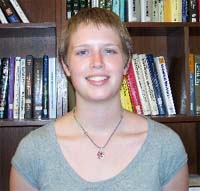
Laura Arnold, "Insights into protoplanetary disk evolution from a Spitzer IRS of NGC1333."
We add to previous Spitzer-IRS mid-infrared surveys of the Taurus, ChamaeleonI and Ophiuchus regions, by studying the spectra of about 50 young stellarobjects (YSOs) in NGC1333. With a median age of less than 1 million years, NGC1333 is a young star forming region. Data from the IRS provide a new,young perspective on the timescale of many phenomenon which affectproptoplanetary disk and envelope evolution, such as degree of settling andcomposition of the disk as well as the formation of gaps or clearings.
Julieta GruszkoJulieta Gruszko, "A Compiled Catalogue of Ca II H & K Chromospheric Activity Measurements for FGK-type HD and HIP Stars."
Advisor: Professor Eric E. Mamajek of the University of Rochester
We present a compiled catalog of chromospheric activity (log(R'HK)) measurements for HIP and HD catalog stars with B-V color between 0.4 and 0.9 (approximately F3 through K2 types). The catalog contains mean log(R'HK) values and basic astrometric and photometric data for 2697 stars, 2065 of which have absolute magnitudes within 1 mag of the main sequence. Chromospheric activity measurements come from 15 previously published surveys. Using the activity-rotation-age calibrations of Mamajek & Hillenbrand (2008), we also estimate fiducial activity ages for the main sequence sample with B-V colors between 0.5 and 0.9. With a preliminary analysis of these ages, we find a possible period of increased star formation, occuring 3 Gyrs ago. We plan to do further analysis of this feature, and on maintaining the compilation as a "living" document to incorporate log(R'HK), measurements from future surveys.
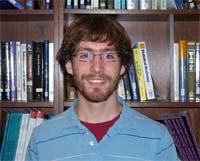
Jonathan Kurvits, "Planar Circular Restricted Three Body Problem (PCR3BP)."
Advisors: Alexander Green, Prof. S. Rajeev, University of Rochester
We investigate two related problems in the Planar Circular Restricted Three Body Problem (PCR3BP):
1. The path of minimum force connecting two points in phase space,
2. The most probable path connecting two points in phase space for a particle experiencing random forces.
We then show that these two paths are in fact the same if the random force is small. Using numerical methods, we find paths to the moon that minimize the square of the applied force.
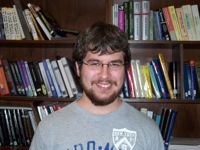
Edward Schroeder, "Modelling Astrophysical Jets: Herbig-Haro Objects."
Advisor: Professor Adam Frank, University of Rochester
During star formation, young stellar objects (YSOs) accrete material from a surrounding envelope onto a central object. The combined effects of conservation of angular momentum and magnetic fields result in streams of material ("jets") emerging from the poles of the object that interact with the heterogeneous interstellar medium (ISM). When observed in emission lines, these jets are referred to as Herbig-Haro (HH) objects. We study these objects computationally, hoping to better understand how the jets are affected by inhomogeneities, or "clumps," within the jet itself. We utilize the AstroBEAR code, developed by the Computational Astrophysics Group at the University of Rochester. AstroBEAR is a modular hydrodynamic and magnetohydrodynamic (MHD) code environment designed for astrophysical applications, based on the BEARCLAW package developed at the University of North Carolina by Sorin Mitran. With AstroBEAR, we are able to run simulations in three dimensions (3D) of HH objects in the hope of revealing the nature of their complex morphology, kinematics, and emission line spectra.
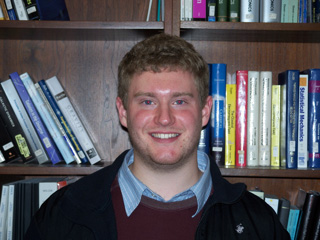
Josh Geller, "Measuring Entanglement in Multi-Qubit Systems."'
Advisor: Professor Eberly, University of Rochester
Entangled multi-qubit systems are studied, considering the difference between pure and mixed states by manipulating the coherence and population elements of two- and threequbit density matrices via phase averaging. A special case of phase averaging is the Xdensity matrix, for which we compute the Concurrence, a two-party entanglement measure calculable from the density matrix. We use an entangled Bell State, or "Schrodinger Cat" state, to demonstrate what is meant by measuring entanglement with Concurrence. This project was supported in part by NSF award PHY-0851243.
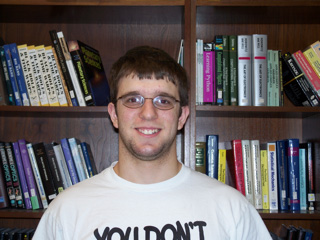
Daniel Gresh, "Design and Implementation of a Timing Control System for use in a Bose-Einstein Condensate (BEC) Experiment."
Advisor: Professor Nicholas P. Bigelow, University of Rochester
A high-precision timing system is required not only to create a BEC, but also to perform experiments on it and control steady-state operations in the lab. I designed, implemented and upgraded the major hardware and logical pieces with microsecond precision on up to 100 digital and analog channels. Supported by NSF award PHY-0851243 and ARO.
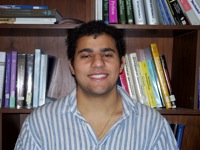
Andrew Sifain, "Magnetic Trapping: An Anti-Helmholtz Configuration."
Magnetic entrapment allows for further investigation of molecules and atoms. The goal is to create a device that creates a magnetic field that possesses a local minimum, pushing the atoms towards a saddle point in their energy thereby creating a "trap." Thus far, the simplest configuration suitable for the trapping experiments are anti-Helmholtz coils; where two coils, parallel to one another, have current running through them and the direction such that the current in one loop opposes that of the other in order to create a magnetic minimum at the center. An analysis of this configuration has led to a better understanding of the optimal positioning and radial dimensions of these coils, as well as information on the detailed geometry of the magnetic fields within the loops. Using the calculated magnetic field profile we are able to characterize the trap in terms of the characteristic oscillation frequencies for trapped particles. The phenomena of spin-flips that can happen near the magnetic field minimum must be considered and has led to an adjustment in the configuration, namely, the addition of a so-called Ioffe-Pritchard loop, which constrains the atoms so that the chance of gaining energy through a change in spin is eliminated. The next step is to further understand the limitations of the trap. Specifically, what types of parameters greatly affect the chance of trapping or of eventual escape as well as practical matters such as the electrical power that must be provided?
Three University of Rochester undergraduates participated in the poster session:
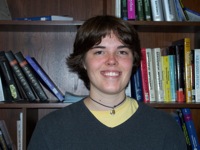
Micaela Bagley, "The Morphology of Galactic Rings Exterior To Evolving Bars: Test Particle Simulations."
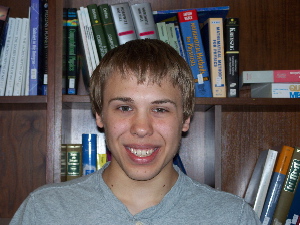
Austen Erickson, "Magnetic properties of the Esquel Pallasite."

Victor Kucherov, "Polarons in DNA Oligomers."
The first twenty-four RSPS conferences were hosted from 1981 through 2005 by the University of Rochester. In 2006, the twenty-fifth RSPS conference was held at Houghton College, New York. In 2007 and 2008, the conference returned to Rochester. In 2009, it was held at the U.S. Military Academy at West Point.
Special Note to Undergraduates: We encourage you to apply to the Research Experience for Undergraduates (REU) program here at the University of Rochester. Examples of recent accomplishments and awards won by Rochester REU students include:
- Stephen Thorndike, who worked with Professor Alice Quillen in the summer of 2002 and discovered a new planet
- Govind S. Krishnaswami, who won the 1999 APS Apker Award for the best undergraduate research in the USA in Physics, for his work with Professor Sarada Rajeev in theoretical particle physics
- Grant Tremblay, Matthew Barczys, and Kevin Flaherty, who each won the Astronomical Society of New York (ANSY) Undergraduate Student Prize for a distinguished research paper in Astronomy in 2000, 2005, and 2006, respectively
- Albert Torr-Jong Wang, who worked in condensed matter physics with Professor Steve Teitel and was one of three Apker Award Finalists in 2001
If you are involved in Physics, Astronomy, or Optics research projects, we strongly encourage you to present your findings at the next RSPS conference. We also urge you to follow up on your research with the goal of giving a presentation at a regular APS meeting (which has a special session for undergraduate research). In addition, you should aim to publish your findings in a regular journal or in the APS Journal of Undergraduate Research.
